For Michael Aranyshev, one of the editors of Russia's Last Hero II, the biggest creative challenge of the reality TV show is where you draw the line between the reality and the show.
"When you present your work to the audience, in the first few seconds you have to establish the tone and make a silent agreement about the measure of authenticity of the stuff you show," he says. "How instant or deliberate is your camera work? Do you uncover the crew presence and, if yes, how soon and in what fashion? It gets even more difficult in a sequel where all the participants watched last year's show and come prepared to act for the camera. Being non-actors they almost invariably ham. It takes a lot of direction on the set to snap them out of it."
Made under license from Survivor, the big-budget Last Hero II is the latest installment in the Russian reality franchise. Gleb Shagoon, director of Moscow's First Field Studio, part of the VID TV group which handled all the CG for Last Hero I, invited Aranyshev to help First Field editor/technical director Andrey Nazarov edit the sequel, which was shot on three islands off the Malaysian coast. Thirteen one-hour episodes were lensed primarily on Sony IMX.
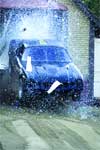
For the current season of Fear Factor, Wexler Video provided Avids for the offline edit; Level 3 Post performed online via an Avid Symphony.
|
The plan for Last Hero II was to "pick the best tool for the job," says Aranyshev. Council and Contest sequences, shot with up to 14 cameras, were slated to be cut by two editors on Discreet's Edit in order to take advantage of the multicamera capabilities of the system. Two more editors were assigned to cut everyday-life segments, shot with a pair of IMX and DV cameras, on Avid Xpress. These editors took 24-hour shifts on location.
Although Nazarov and Aranyshev were supposed to handle final color grading and finishing, they too were sent to Malaysia, taking four complete Pinnacle CineWave systems - two for editing, two for logging and back up - to Pulau Besar Island where the editors and crew resided. CineWave, which works in offline and online modes, is a comprehensive uncompressed editing solution. It includes Apple's Final Cut Pro (FCP) and a full version of Pinnacle's Commotion Pro, and runs on the Power Mac G4.
All of the editors on the show questioned the wisdom "of trying to produce finished product on location," Aranyshev says. "We felt it would be much smarter to cut together rough assemblies of each sequence to see how they came together and whether a few additional shots would help a story or even save a particular scene. You don't go back for additional shooting months later for a reality TV show."
At press time, the episodes are being recut and finished by Nazarov in the VID TV office on a single CineWave with new rough cuts from Avid Xpress - and sometimes "with no rough cut at all," Nazarov reports. "Despite the overkill of taking all these systems on location, the idea of offlining on Avid and onlining on CineWave has been a smart one indeed," Aranyshev says.
Nazarov isn't getting much time to sleep with a five-day turnaround per episode, however. The typical schedule calls for clean cutting an episode in three days, tightening it the next, then performing color correction and audio post on the Friday before going to air on Saturday. "Producer Sergei Kushnerev, director Sergei Airapetov and I do the whole show on a dual-gig G4 with 3 TB of Medea RTRX," says Nazarov. "We're only on episode nine, and it's much more like a feature than a TV show!"
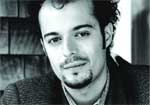
Northern Lights has cut over 24 episodes of MTV's Cribs on Media Composers, including this one with Tommy Lee. Editor David Gioiella is inset.
|
He says "Final Cut Pro was chosen for its all-in-one solution for editing, compositing, effects and color correction, plus its speed." Effects for the TV show are done with FCP and Commotion - we don't have time for anything else," Nazarov explains. More extensive effects may be created for the show's release on DVD.
"The visual approach taken for Last Hero II was to give it some adventure-movie glamour, Romancing the Stone-style," says Aranyshev. "It required cameramen to go for that particular look, Andrey and me to play with CineWave image controls [there are quite a few ad hoc day-for-night shots made with FCP's three-way color corrector] and directors on set to steer the action toward some pre-planned collisions."
Welcome to Survivor AustralIA, Mate
Survivor also has a franchise Down Under. Australian Survivor featured 13 one-hour episodes shot at an isolated location on the South Australian coast. It aired from February to May 2002. "We began editing on location virtually as soon as we started shooting," recalls Stephen Peters, executive producer at Nine Network in Sydney. "The shoot went for six weeks, then we packed everything back into a more permanent facility" at the network.
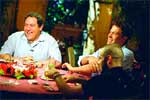
Editor Dan Lebenthal is currently cutting season two of Dinner for Five. The premiere episode features Ben Affleck and Colin Farrell.
|
On location, four Matrox DigiSuite LEs running Incite Multimedia Corporation's (IMC) Incite Editor were connected to an IBM server with 2.7 TB of storage and used for the editing process. Two or three digitizing stations were also connected to the server. Up to 14 more machines were hooked up to the same server for logging.
"A big selling point for Incite was its powerful logging," notes Ian Andes, the show's technical editing consultant. "I don't think the show could have been done without it."
The cost-effective, networked Matrox DigiSuite systems enabled the producers and four editors to access footage simultaneously. "The producers would come into our field office and log their material from the day before" on the logging stations, Peters explains. "Each day's footage would be digitized overnight ready for the producers and editors the next day. The technical challenges were huge given that we had 10 crews [shooting] every day for 40 days. This generated an enormous amount of footage."
Andes points out that "once the tapes were digitized, the producers could watch the footage, mark in and out points, make notes and transcribe all conversations. They'd see full-motion video on the logging stations and not interrupt what the editors were doing. Once the in and out points were marked, the producers could go to the editors who, from the log, would drag-and-drop the clip onto the timeline. This saved an enormous amount of time."
Andes believes approximately 1,200 tapes, mostly 40-minute Digi Beta tapes, were accumulated by the end of production. "The versatility of the hardware coupled with the advanced capabilities of the Incite software with its logger were a huge advantage," says Andes. "The DigiSuite hardware allowed us to go to compression ratios of 1 to 2 megs per second, which the editors were more than happy with, or we could go to 7 megs per second for broadcast quality. What took DigiSuite 7 megs per second would have taken the competition 15 megs per second for the same video quality."
Even though the producers and editors knew the outcome of the competition before the series went to air, they couldn't lose sight of "the big picture." They needed to structure Australian Survivor over 13 episodes with "each individual episode having its own highs and lows," Peters says. There were six commercial breaks in every show "and you always want to go to them with some sort of question or moment of intrigue," he adds.
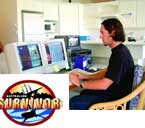
Ben Frost is pictured editing Survivor Australia on a Matrox DigiSuite set-up. The show-s logo was created in-house at TCN Channel Nine, Sydney.
|
Peters emphasizes that, "we treated the stories the same way we would work with a drama script. It's the story and the characters that are paramount. By logging everything that is said on location and knowing all the various overlapping storylines you need to have a plan as to how each episode will pan out. You then use the various conversations, actions sequences, et cetera to guide the viewer to the end result." He points out that what may have seemed like an inconsequential conversation between two competitors "could contain key elements to help producers turn the main storyline in a particular direction" when viewed in context with everything else that happened the same day.
Every frame of the series was color graded out of house to give a particular look - golden hues with a slightly harder contrast - that Peters was after.
Straight Talk At Dinner
If down-and-dirty, competition-based reality programs pose the challenge of "where to draw the line between the reality and the show," as Last Hero II's Michael Aranyshev puts it, reality is the show for The Independent Film Channel's (IFC) Dinner For Five."
Conceived, executive produced and hosted by actor/writer/director Jon Favreau (Made, Daredevil), each episode of Dinner For Five finds him in a restaurant joined by four entertainment-industry guests. They share an evening of fine dining and unscripted dialogue as they banter about life on and off the set.
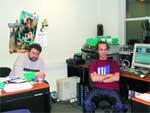
L-R: Last Hero II director Sergey Ayrapetov and technical director Andrey Nazarov.
|
Feature film editor Dan Lebental, owner of Hollywood's Park Place Editing, is currently cutting the second season of Dinner For Five. He started editing the show as a favor to his friend Favreau - Lebental had edited Very Bad Things in which Favreau co-starred with Christian Slater and Cameron Diaz - and has stayed with the project despite other movie gigs (he's now editing 11:14 starring Hilary Swank and Patrick Swayze).
Each episode of Dinner For Five provides Lebental with three to four-and-a-half hours of tape, which he must reduce to a 30- or 45-minute show, a flexibility that's allowed since it airs on the Independent Film Channel and not a major network. "The biggest part is editing in the literary sense: What topics are interesting? How do we achieve balance? Every dinner tends to have a dominant guest but you have to pay attention to everybody."
Since each show is centered on the dinner itself - chit-chat with wait staff and what everyone's eating are part of the fun - Lebental must pay attention to the dining chronology. "I can't show people having appetizers after Jon lights up his cigar," the editor notes. "I don't cheat very much. There may be a little reordering, but I'm careful to watch the table. And between cuts I don't do a lot of stealing: I don't manufacture laughs or reactions that aren't real."
Each show's source material is characterized by "a warm-up period" as the very diverse guests (diners have included Peter Falk, Vince Vaughn, Garry Shandling and Cheri Oteri in one group and the late Rod Steiger, Kevin Pollak, Sarah Silverman and Ron Livingston in another) get to know each other.
Lebental has been surprised by what, at least at first glance, "makes a good show. You can get fooled by an overall dinner," he observes. "When they shot the show with Rod Steiger, there was a difficult chemistry between the diners. We thought, this one is a train wreck. But once I pared it down, it started to become one of the best shows." Conversely, "sometimes a dinner seems great, everyone's getting along but the bantering doesn't get very topical, it doesn't cut through. Conflict is the essence of drama, and sometimes you need to find that in order to bring out what's interesting."
A longtime Avid owner, Lebental cuts Dinner For Five at an offline resolution on a Media Composer. "It's a five-camera show so I get all the ISOs. There's a line cut which I use as a bed to cut over."
Lebental typically screens all the footage, breaks it down by topic, gets everything listed in a bin and marks the material that "immediately captures" his interest. He starts building the show from there, winnowing the footage to 30 to 45 minutes by the time he sits down with Favreau and producer Peter Billingsley to discuss the contents. "Sometimes there seems to be something missing so we go back to the source material," Lebental says. "Jon and Peter are also looking for things I don't know, sensitivities people may have that I'm not aware of."
Lebental does simple topical titles on the first pass as well as the music edit. He draws from an original library of some 50 musical cues created for the series. When a show is complete, it's sent to The Post Group for "uprezing, light color correction and sound mixes if needed." Finishing is done on an Avid Symphony.
Lebental notes that "unlike other shows, the format of Dinner For Five doesn't have to be the same every time. In fact, it tries to avoid repeating itself. The hard part is to discover the nature of each show."
Reality, MTV Style
What happens when MTV's signature look and style meet the demands of reality TV? Editors David Gioiella and Mark Littman, partners in seven-year-old Northern Lights Post (www.nlpedit.com) in New York City, know. They've lent their expertise to a number of MTV series, cutting two seasons of the daily Mattrock series, more than a dozen episodes of MTV Diary, and over 24 episodes of Cribs, which the partners describe as Lifestyles of the Rich and Famous turned up a few notches."
Even though they're cutting for MTV, the editors face a lot of the same challenges as other editors of other reality programming. "Reality TV isn't just turning the camera on," says Littman. "Anybody who shoots home movies with a camcorder is making reality TV. What we're doing is taking mundane footage your friends wouldn't want to watch when they come over and turning it into something that gets really good ratings."
The partners' often seamless editing sometimes makes viewers wonder if a program has been edited at all. "The best editing is editing you don't notice," Littman points out. "The fact that people ask us, 'what do you edit in these shows?' demonstrates how much we do edit."
Gioiella notes that "we've worked on some Diary shows where the artist isn't really that interesting. You get three days of video of this person walking in a mall, driving a car and talking to his girlfriend on the phone and you have to figure out what's interesting about this? Where's the story?" The editors are charged with creating an episode that doesn't give viewers an inkling that the subject isn't a very compelling personality.
Sometimes style and technique come to the rescue. "The way a person picks up a glass may not be interesting, but if you show it three times in a row quickly and cut to a beat of music it becomes interesting," notes Littman. Producers also offer guidance about how to "uphold the image" of the artist being profiled, says Littman. "Sometimes a producer will say, 'this guy needs to look cooler than this.' They want the artists to look as slick as possible."
With Cribs, the editors were called upon to develop a unique look for a budget-conscious show with a fast production and post cycle. "We were expected to come up with ways, mostly in editorial, to make the footage stand out," Gioiella says.
The first episode of Cribs featured segments on the homes of Ozzy Osbourne, Carmen Electra and Master P. "The producers said the material wasn't that interesting so we tried to focus on the people as much as possible, so there was a balance between the objects in a house and the personality telling you about those objects," explains Gioiella. "The greatest moments were when those two things merged: when someone picked up something from a shelf and it led to an interesting story," Littman reports. In that case the editors might let the scene play out a bit, "but it's still Cribs, so the producers expect you to do something - embellish with B-roll, add music and sound effects - so it's not just a talking head," Gioiella emphasizes.
The editors cut the MTV shows with Avid Media Composers, which have been "souped up" with GenArts Sapphire effects to add film grain, layer imagery and craft titles. They also make extensive use of the Adobe suite of software. "We really push the machines to do as much in-house as we can to maximize the post budget," says Gioiella. "Most shows originate on Beta or DV. Most stuff is edited uncompressed or 2:1 compressed out of the Media Composers. But we can go out to Symphony if necessary."
MTV being MTV, music plays a particularly key role in these reality series. "Music and sound are mostly done in Avid; they're closely tied with editorial," notes Gioiella. "It's second nature to listen to a piece of music, break it apart, shorten or lengthen it, move it around. It's as much a skill as editing visually."
Littman points out that "the audio track has to sound like a DJ mixed it. It's got to flow, no transitions. It's got to make sense. Now when I listen to music in my everyday life I'll hear something and think that might work in editorial and keep it tucked away in the back of my mind until it's time to tell a producer, 'let's try this.'" Fortunately, since MTV has access to any music tracks of artists appearing on the network, paying high prices for music rights to tunes used in shows is avoided.
The editors say they've been able to apply what they've learned on Diary and Cribs to spot work. "We do a lot of commercials," says Gioiella, "and we've drawn on our skill set in music editing and putting things together in an interesting way to show creative teams how editing can really make a difference."